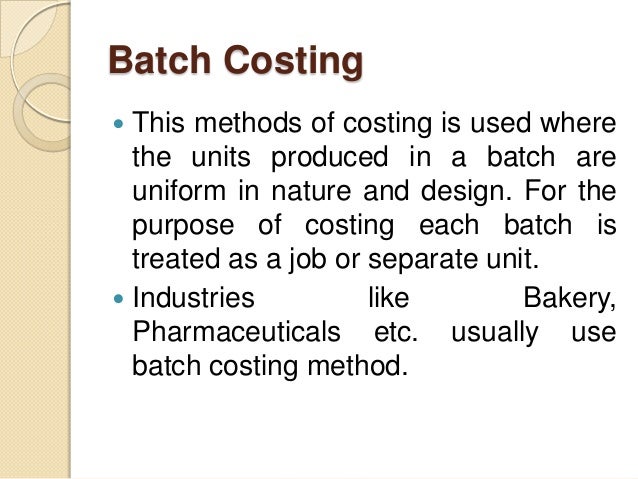
It is a method of costing by the unit of production, where manufacturing is continuous and the units are identical. In some cases the units may be differ in terms of size, shape, quality etc. This method is also called as Single Costing because only one type of product alone is manufactured. But according to Mr. Batty, “Many costing systems do not fall neatly into the category of either job or process costing. It is, for this reason, that he uses the term “hybrid costing systems” for all those methods that combine the features of the basic costing methods.
Job Costing
Keeping this level of particular cost detail in inventory is unnecessary. There aren’t any items with high price tags or distinctive cost structures. Based on lean performance measures, this gives the organization an idea of where waste may be reduced. On the other side, you don’t own short-term assets for a long enough period of time for their value to drastically fluctuate.
7: Introduction to Cost Accounting Methods
You will learn what cost accounting is and how cost accounting relates to corporate accounting. Thereafter, you will get familiar with some basic cost terms that are essential for cost accountants. Finally, we will introduce you to a framework that distinguishes three sub-systems of cost accounting. This costing method is typically used for external reporting purposes, such as calculating your cost of goods sold. Opportunity cost is the benefits of an alternative given up when one decision is made over another.
Get in Touch With a Financial Advisor
It’s also useful for companies that need to know how much it costs them to produce one unit because they make several types of products and want to compare them. The company can then use this information to make informed pricing decisions, adjust production processes, and allocate resources more effectively. Job costing is assigning costs to individual jobs or products a company creates.
Controllable Costs
- Because prices typically increase over time, FIFO often shows higher levels of profit compared to other methods because it assumes you sold the cheaper goods before the goods with inflated prices.
- The cost can be found out only by finding out the cost per tonne of total oil produced and then multiplying it by ten.
- Understanding your business priorities will guide you to the right costing method.
- However, a business with variable yearly costs may not recover the costs of more expensive products under this method.
- This lack of accuracy has led cost accountants to search for new, fairer ways to charge production units for their share of indirect expenses.
Some ABC systems rank activities by the degree to which they add value to the organization or its outputs. In addition, this method does not provide information about where cost variances occur. Each approach establishes the cost of the inventory that is allocated to Cost of Goods Sold (CGS)/Work in Progress (WIP). This enables the company’s management team to guard the enterprise against any eventuality. Estimates, plans, budgets, and other aids are provided to management to compare the desired results and the actual results.

Continuous Operation Costing
This method is applied to the organisations which are engaged in rendering services such as – Transport – Railways, Road, Airways; Hospitals; Power House; Canteens; etc. This method, therefore, aims at ascertaining the cost of services rendered. Then the costs are absorbed by products and services based on their use of activities. It is applied in concerns involved in construction work, like laying of roads, bridges and buildings, etc. For each of the contracts a separate account is opened and the total cost incurred is identified with it.
Traditional cost accounting techniques allocate costs to products based on attributes of a single unit. It is a ‘one-off’ operation and each job is considered as a cost unit and to some extent the cost centre also. When a job is finished its cost is compiled separately by adding all materials, labour and overhead costs booked against it. Each job is distinct or of different nature and needs special treatment, more detailed supervision and control.
This is a reasonable definition, but it only addresses the dimensions of technique and process. A financial professional will offer guidance based on the information provided and offer a no-obligation call to better understand your situation. Our mission is to empower readers with the most factual and reliable financial information possible to help them make informed decisions for their individual needs. Our writing and editorial staff are a team of experts holding advanced financial designations and have written for most major financial media publications. Our work has been directly cited by organizations including Entrepreneur, Business Insider, Investopedia, Forbes, CNBC, and many others. This team of experts helps Finance Strategists maintain the highest level of accuracy and professionalism possible.
Controllable costs are categorized as short-term costs as they can be adjusted quickly. For example, a company decides to buy a new piece of manufacturing equipment rather how to choose the right payroll software for your business than lease it. However, the electricity used to power the plant is considered an indirect cost because the electricity is used for all the products made in the plant.
The advantages of accuracy must be weighed against the expense of devoting a lot of time and resources to this task. Or, to put it another way, over time, increasing inputs of variable costs will result in progressively fewer units of output. However, fixed costs are limited to a set time period because they can fluctuate over the long term. A manufacturer, for instance, can opt to raise capacity in response to the rise in demand for its product.
